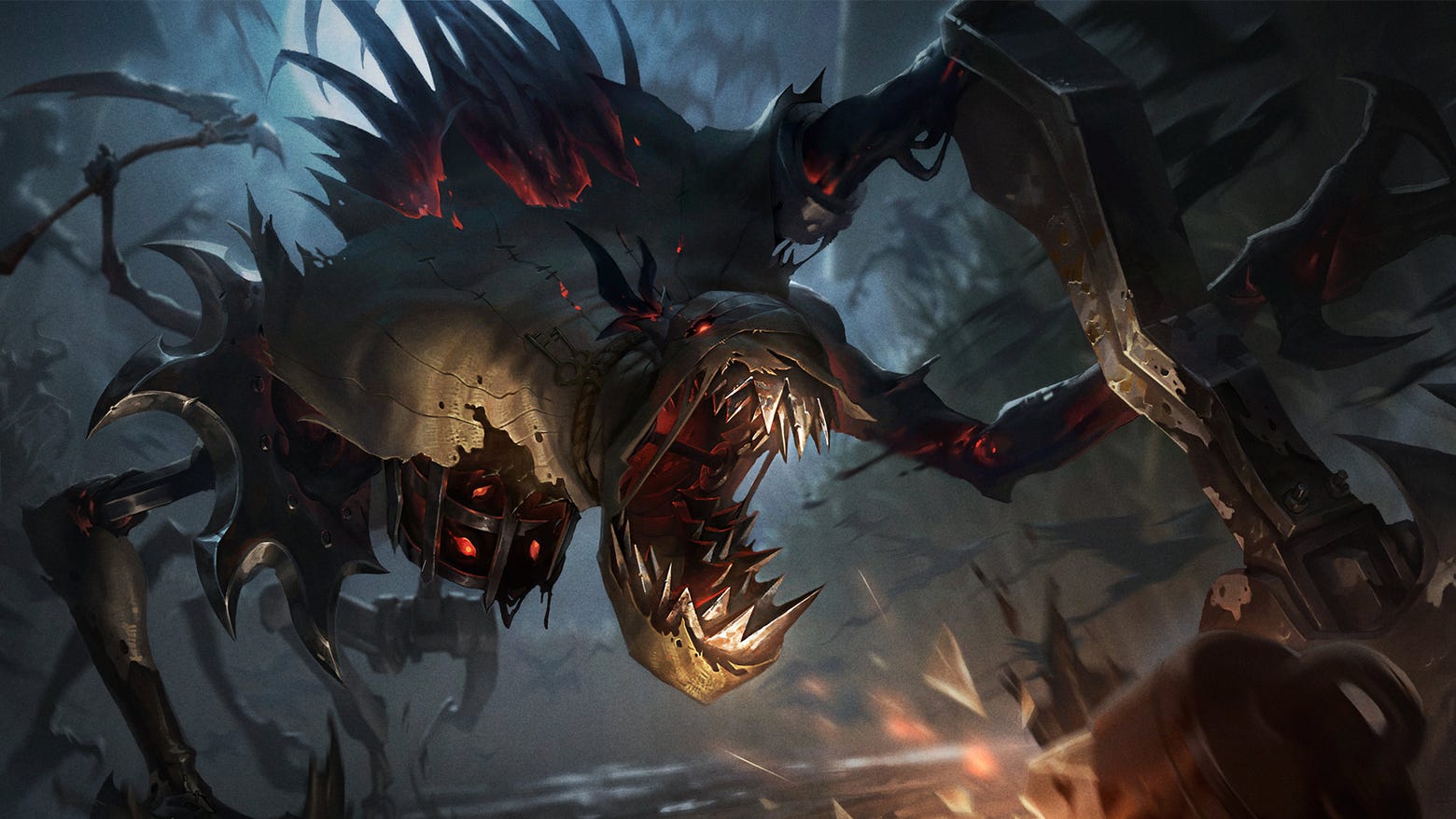Welcome to Ask Riot!
Before we get to the spook, we have an announcement: You can now submit your questions again! To do so, head over to the new submission page, drop your question in the box, and send away. Thanks for bearing with us as we adjusted to the new site. Now for today’s topics…
This week, we’re talking splash art, item lore, and how we created Fiddle’s new VO.
How’d you make the VO for Fiddlesticks? It’s spooky af.
As you might expect, crafting the iconic voice of a champion begins with a compelling—and in this case, brilliantly spine-tingling—performance from the voice talent. When you start with a deeply evocative portrayal of the character through sublime voice acting, my job as a VO designer becomes a lot easier. It unlocks the ability to take a really interesting starting point and push it to the next level of the otherworldly, the unsettling, and the downright weird.
As soon as I heard the early auditions for Fiddlesticks, I was hooked. Kellen Goff, the voice actor, brought a stunning range of dynamic textures and colors to Fiddle’s voice during records, which gave me an amazing performance to push and pull, splice and enhance to unearth those special and bone-chilling moments. The sessions with Kellen yielded gem after gem of self-contained horrifying textures that I simply needed to glue together into a mosaic of death.
To see how Kellen does it, check out his video below (3:40 and 4:58 are both spooky spots.)
When it came to the core design, it felt only appropriate that the voice of Fiddlesticks would serve as a sonic parallel to the creature itself: a dry, rattling, disjointed, vaguely humanoid form with a terrible demonic presence just out of sight, occasionally peeking through and threatening to burst forth. To this end, I started tinkering with a lot of different effects: some subtle, deeper doubled textures that would intensify on certain sinister words; a hint of a dark, cold, oppressive reverb; and even some inhuman animal and insect textures woven throughout. It was important that Fiddle never felt like it was utilizing the anatomical tools of a human with a voice: lips, lungs, or any other organic matter. It couldn’t get too wet, too gurgly, too feral. That’s not who Fiddle is. It’s a macabre, breathless monster driven by a deep need to hunt without truly understanding speech.
- Riot Zimerfly, VO Director
Is item specific lore a thing that could happen? I don’t know about anyone else, but I personally would love to read a canonical short story involving the items of Runeterra. Rabadons, Lich Bane, etc.…
For many folks, one of the most exciting things about League of Legends (the MOBA) is all the tiny little nuggets of lore scattered throughout it from the past ten years of development. And while some of the shop items are fairly unremarkable, others almost cry out for a proper backstory. Sometimes literally.
However, it can be tricky—though not impossible—-to tell an interesting narrative entirely focused on a sword, or a piece of armor, or a magic gem. A weapon can’t generally be the protagonist of a story… unless it’s one of the five remaining Darkin, of course. But stories with great characters that also feature these artifacts in some way? Heck yes, sign me up. I want to learn more about this Doran fella…
I’ve seen some fantastic theories out there about, say, the Lost Chapter, Tear of the Goddess, or the legendary Blade of the Ruined King, and it’s almost certain that we will tell more stories featuring items like this in the not-too-distant future.
- Riot Scathlocke, Narrative Editorial Director
Why do in-game models sometimes differ from splash art so much? For example, Nightbringer Aphelios is black and red in his splash, but has a lot of blue in his actual model. Aside from instances like Blood Moon Aatrox where the color saturation is upped for better gameplay clarity, what is the reason for these differences?
While splash art and in-game models are closely connected, they have different goals. With in-game models, the top priority is gameplay readability. Since splash doesn’t have that consideration, our big goal is to create deep immersion and something we call “cinematic believability” in our illustrations. You can think of this the same way a comic book character translates to a big blockbuster movie. The movie version will have higher-detail fidelity in the costume, materials, and render, including invented details that didn’t exist in other versions. There will also be dynamic, moody lighting depending on the scene’s emotional tone or setting. We even think about things like camera distortion, lens flares, dust motes in the air, and film grain. All of this stacks up to make something more believable, and more cinematic, than other representations can achieve.
Sometimes the mood and light can mean colors aren’t as punchy as they might be in the model textures—like Nightbringer Aphelios’s cool, dark scenario—and it can also make other colors really pop, like the bright red tassels on his jacket. That said, we don’t want the splash art to feel totally different from what you see in game, so we do take the time to compare the splash to the in-game model—we even try to “model” the character so they match the pose in the splash art.

Ultimately, we want to make sure we’re keeping splashes and models close to each other while still hitting our unique goals.
- Riot Owleycat, Illustration Art Lead
